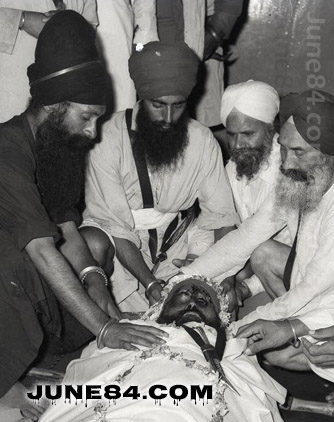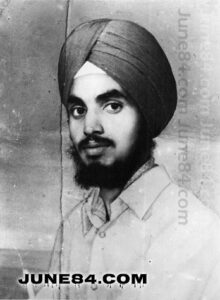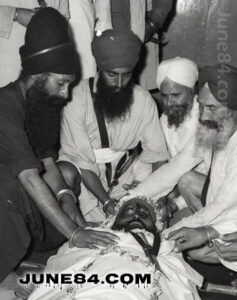On the morning of April 14, 1978, the day following the tragic incident, the law enforcement team led by the Senior Superintendent of Police and Deputy Commissioner conducted a thorough search of the Nirankari Bhavan premises. During the search, they confiscated a significant cache of firearms and the attire worn by individuals associated with the Nirankari group.

The Akhand Kirtani Jatha presented two specific requests to the authorities. Firstly, they sought justice in accordance with the law. Secondly, they requested an assurance that there would be no further disrespect shown towards Siri Guru Granth Sahib Ji. Regrettably, neither of these appeals received a satisfactory response. Legal action was initiated against Gurbachan Singh, the leader of the Nirankaris, and sixty-two of his followers.
Similarly, a case was filed against Naranjan Singh I.A.S. However, for reasons not entirely clear, the Delhi police authorities did not execute the warrants issued by the Sessions Judge. Eventually, all individuals involved were acquitted. Surprisingly, Gurbachan Singh remained undeterred by this grim incident and persisted in showing disrespect for Siri Guru Granth Sahib Ji.
The Nirankari sect was believed by some to have been influenced or supported by the Indian government as a means to create division within the Sikh community. In late April 1978, The Indian Express (Chandigarh Edition) published a report by Sat Pal Baghi, who suggested that Indira Gandhi actively endorsed the Nirankaris. Baghi asserted:
“The real reason for the Akalis and Nirankaris conflict dates back to when Indira Gandhi was in power as Prime Minister of the Union government. She aimed to weaken the Shiromani Akali Dal, but her efforts to control them were unsuccessful. As an alternative, she devised an extensive plan to promote and strengthen the Nirankari sect, not only in Punjab but also nationally and internationally. This official backing of the Nirankaris enraged the Akalis, who have always considered the Nirankaris as heretics.”
During Indira Gandhi’s tenure, the Nirankaris reportedly received financial support from undisclosed government funds, which were not subject to parliamentary oversight. Indira Gandhi ensured that the Congress government would provide official support to the Nirankari leader. H.S. Chhina I.A.S, a dedicated Nirankari, was appointed as the Chief Secretary of the Punjab Government in 1976.
As a consequence of this conspicuous official support and financial assistance, the Nirankaris gained significant political influence within the administrative structure of the Punjab Government. H.S. Chhina appointed Niranjan Singh I.A.S as the Deputy Commissioner of Gurdaspur, and the latter made substantial efforts to expand the activities of the Nirankaris.
—Sura (Amritsar) -Monthly Magzine, by AKJ, May 1978
ਸਾਕੇ ਤੋਂ ਬਾਅਦ ਦਾ ਘਟਨਾਕ੍ਰਮ
ਕਤਲੇਆਮ ਤੋਂ ਅਗਲੇ ਦਿਨ 14 ਅਪ੍ਰੈਲ 1978 ਨੂੰ ਐਸ. ਐਸ. ਪੀ. ਅਤੇ ਡਿਪਟੀ ਕਮਿਸ਼ਨਰ ਦੀ ਅਗਵਾਈ ਵਿੱਚ ਪੁਲਿਸ ਫੋਰਸ ਨੇ ਨਿਰੰਕਾਰੀ ਭਵਨ ਦੀ ਤਲਾਸ਼ੀ ਲਈ । ਪੁਲਿਸ ਉਥੋਂ ਵੱਡੀ ਮਾਤਰਾ ਵਿੱਚ ਹਥਿਆਰ ਅਤੇ ਨਿਰੰਕਾਰੀ ਬਦਮਾਸ਼ਾਂ ਵੱਲੋਂ ਪਹਿਨੀਆਂ ਵਰਦੀਆਂ ਚੁੱਕ ਕੇ ਲੈ ਗਈ।ਅਖੰਡ ਕੀਰਤਨੀ ਜਥੇ ਵੱਲੋਂ ਪ੍ਰਸ਼ਾਸਨ ਅੱਗੇ ਦੋ ਮੰਗਾਂ ਰੱਖੀਆਂ ਗਈਆਂ । ਪਹਿਲੀ ਕਾਨੂੰਨ ਅਨੁਸਾਰ ਇਨਸਾਫ ਦੀ ਮੰਗ ਤੇ ਦੂਸਰੀ ਇਸ ਗੱਲ ਦਾ ਭਰੋਸਾ ਮੰਗਿਆ ਗਿਆ ਕਿ ਕੋਈ ਵੀ ਭਵਿੱਖ ਵਿੱਚ ਗੁਰੂ ਗਰੰਥ ਸਾਹਿਬ ਜੀ ਦਾ ਨਿਰਾਦਰ ਨਾ ਕਰ ਸਕੇ । ਪਰ ਇਹ ਦੋਵੇਂ ਮੰਗਾਂ ਮੰਨੀਆਂ ਨਾ ਗਈਆਂ । ਨਿਰੰਕਾਰੀ ਮੁਖੀ ਗੁਰਬਚਨ ਸਿੰਹੁ ਤੇ ਉਸਦੇ 62 ਚੇਲਿਆਂ ਖਿਲਾਫ ਕੇਸ ਦਰਜ ਕੀਤਾ ਗਿਆ । ਇੱਕ ਕੇਸ ਆਈ. ਏ. ਐਸ. ਅਧਿਕਾਰੀ ਨਿਰੰਜਨ ਸਿੰਘ ਖਿਲਾਫ ਵੀ ਕੀਤਾ ਗਿਆ । ਕੁਝ ਅਣਜਾਣ ਕਾਰਨਾਂ ਕਰਕੇ ਸੈਸ਼ਨ ਜੱਜ ਵੱਲੋਂ ਜਾਰੀ ਕੀਤੇ ਗਏ ਵਰੰਟਾਂ ਦੀ ਦਿੱਲੀ ਪੁਲਿਸ ਨੇ ਤਾਮੀਲ ਨਾ ਕੀਤੀ। ਅਖੀਰ ਤੇ ਇਹ ਸਾਰੇ ਲੋਕ ਅਦਾਲਤ ਵਿੱਚ ਬਰੀ ਹੋ ਗਏ। ਗੁਰਬਚਨ ਸਿੰਹੁ ਨੇ ਅੰਮ੍ਰਿਤਸਰ ਵਿੱਚ ਵਾਪਰੀ ਘਟਨਾ ਤੋਂ ਕੋਈ ਸਬਕ ਨਾ ਲਿਆ । ਉਸ ਨੇ ਗੁਰੂ ਗਰੰਥ ਸਾਹਿਬ ਜੀ ਖਿਲਾਫ ਊਲ ਜਲੂਲ ਬੋਲਣਾ ਬੰਦ ਨਾ ਕੀਤਾ ।
ਨਿਰੰਕਾਰੀ ਭਾਰਤ ਸਰਕਾਰ ਦੀ ਪੈਦਾਇਸ਼ ਸਨ ਤੇ ਇਹਨਾਂ ਨੂੰ ਸਿੱਖਾਂ ਵਿੱਚ ਵੰਡੀਆਂ ਪਾਉਣ ਲਈ ਤਿਆਰ ਕੀਤਾ ਗਿਆ ਸੀ । ਇੰਡੀਅਨ ਐਕਸਪ੍ਰੈਸ ਦੇ ਚੰਡੀਗੜ੍ਹ ਐਡੀਸ਼ਨ ਵਿੱਚ ਸੱਤਪਾਲ ਬਾਗੀ ਦੀ ਇੱਕ ਰਿਪੋਰਟ ਅਪ੍ਰੈਲ 1978 ਵਿੱਚ ਛਪੀ ਸੀ । ਉਸ ਮੁਤਾਬਕ ਇੰਦਰਾ ਗਾਂਧੀ ਨਿਰੰਕਾਰੀਆਂ ਦੀ ਪੁਸ਼ਤ-ਪਨਾਹੀ (ਮਦਦ) ਕਰ ਰਹੀ ਸੀ। ਰਿਪੋਰਟ ਮੁਤਾਬਕ :
‘’ਨਿਰੰਕਾਰੀਆਂ ਅਤੇ ਅਕਾਲੀਆਂ ਵਿਚਾਲੇ ਅਸਲ ਸਮੱਸਿਆ ਦੀ ਜੜ੍ਹ ਉਦੋਂ ਦੀ ਹੈ ਜਦੋਂ ਇੰਦਰਾ ਗਾਂਧੀ ਭਾਰਤ ਸਰਕਾਰ ਦੀ ਅਗਵਾਈ ਕਰ ਰਹੀ ਸੀ । ਉਹ ਅਕਾਲੀ ਦਲ ਨੂੰ ਕਮਜ਼ੋਰ ਕਰਨਾ ਚਾਹੁੰਦੀ ਸੀ ਤੇ ਆਪਣੇ ਇਸ ਮਕਸਦ ਵਿੱਚ ਸਫਲ ਨਹੀਂ ਸੀ ਹੋ ਰਹੀ । ਉਸ ਨੇ ਇੱਕ ਯੋਜਨਾ ਤਿਆਰ ਕੀਤੀ ਜਿਸ ਅਧੀਨ ਨਿਰੰਕਾਰੀ ਡੇਰੇ ਨੂੰ ਪੰਜਾਬ ਅਤੇ ਪੂਰੇ ਭਾਰਤ ਵਿੱਚ ਹੀ ਨਹੀਂ ਬਲਕਿ ਵਿਦੇਸ਼ਾਂ ਵਿੱਚ ਵੀ ਮਜ਼ਬੂਤ ਕਰਨਾ ਸੀ । ਨਿਰੰਕਾਰੀਆਂ ਨੂੰ ਪੂਰੀ ਸਰਕਾਰੀ ਸ੍ਰਪਰਸਤੀ ਦਿੱਤੀ ਗਈ ਸੀ। ਅਕਾਲੀਆਂ ਨੇ ਇਸ ਗੱਲ ਦਾ ਵਿਰੋਧ ਕੀਤਾ ਕਿਉਂਕਿ ਉਹ ਨਿਰੰਕਾਰੀਆਂ ਨੂੰ ਨਾਸਤਿਕ ਸਮਝਦੇ ਸਨ ।‘’
ਪਾੜੋ ਤੇ ਰਾਜ ਕਰੋ ਦੀ ਨੀਤੀ ਤਹਿਤ ਇਦਰਾ ਗਾਂਧੀ ਨੇ ਨਿੱਜੀ ਤੌਰ ਤੇ ਨਿਰੰਕਾਰੀ ਮੁਖੀ ਨੂੰ ਡਿਪਲੋਮੈਟਿਕ ਪਾਸਪੋਰਟ ਦੇਣ ਦੀ ਪ੍ਰਵਾਨਗੀ ਦਿੱਤੀ । ਭਾਰਤੀ ਹਾਈ ਕਮਿਸ਼ਨਾਂ ਤੇ ਅੰਬੈਸਡਰਾਂ ਨੂੰ ਨਿਰੰਕਾਰੀ ਮੁਖੀ ਦਾ ਆਦਰ ਸਤਿਕਾਰ ਕਰਨ ਦੀ ਹਦਾਇਤ ਦਿੱਤੀ ਗਈ । ਅਜਿਹਾ ਨਿਰੰਕਾਰੀ ਡੇਰੇ ਦੀ ਮਸ਼ਹੂਰੀ ਕਰਨ ਲਈ ਤੇ ਡੇਰੇ ਦੇ ਪੈਰੋਕਾਰਾਂ ਦੀ ਗਿਣਤੀ ਵਧਾਉਣ ਲਈ ਕੀਤਾ ਗਿਆ ।
ਇੰਦਰਾ ਗਾਂਧੀ ਦੇ ਸ਼ਾਸਨ ਕਾਲ ਦੌਰਾਨ ਨਿਰੰਕਾਰੀਆਂ ਨੂੰ ਵਿੱਤੀ ਸਹਾਇਤਾ ਵੀ ਮਿਲਦੀ ਰਹੀ ਜੋ ਕਿ ਸੰਸਦੀ ਪੜਤਾਲ ਤੋਂ ਬਾਹਰੀ ਸੀ। ਇੰਦਰਾ ਗਾਂਧੀ ਨੇ ਯਕੀਨੀ ਬਣਾਇਆ ਕਿ ਕਾਂਗਰਸ ਦੇ ਸ਼ਾਸਨ ਕਾਲ ਦੌਰਾਨ ਨਕਲੀ ਨਿਰੰਕਾਰੀਆਂ ਨੂੰ ਸਰਕਾਰੀ ਸ੍ਰਪਰਸਤੀ ਮਿਲਦੀ ਰਹੇ । ਇਸੇ ਤਹਿਤ ਕੱਟੜ ਨਿਰੰਕਾਰੀ ਆਈ. ਏ. ਐਸ. ਐਚ. ਐਸ. ਛੀਨਾ ਨੂੰ 1976 ਵਿੱਚ ਪੰਜਾਬ ਸਰਕਾਰ ਦਾ ਚੀਫ ਸੈਕਟਰੀ ਨਿਯੁਕਤ ਕੀਤਾ ਗਿਆ ।
ਖੁਲ੍ਹੇਆਮ ਮਿਲ ਰਹੀ ਸਰਕਾਰੀ ਸ੍ਰਪਰਸਤੀ ਤੇ ਵਿੱਤੀ ਸਹਾਇਤਾ ਕਾਰਨ ਨਿਰੰਕਾਰੀਆਂ ਨੂੰ ਪੰਜਾਬ ਸਰਕਾਰ ਦੇ ਪ੍ਰਸ਼ਾਸਨਿਕ ਹਲਕਿਆਂ ਵਿੱਚ ਕਾਫੀ ਹੁਲਾਰਾ ਮਿਿਲਆ । ਐਚ. ਐਸ. ਛੀਨਾ ਨੇ ਨਿਰੰਜਨ ਸਿੰਘ ਆਈ. ਏ. ਐਸ. ਨੂੰ ਗੁਰਦਾਸਪੁਰ ਦਾ ਡਿਪਟੀ ਕਮਿਸ਼ਨਰ ਨਿਯੁਕਤ ਕੀਤਾ । ਫਿਰ ਨਿਰੰਜਨ ਸਿੰਘ ਨੇ ਆਪਣਾ ਸਾਰਾ ਜ਼ੋਰ ਨਿਰੰਕਾਰੀਆਂ ਦਾ ਪੰਜਾਬ ਵਿੱਚ ਕਾਰਜ ਖੇਤਰ ਵਧਾਉਣ ਲਈ ਲਾਇਆ ।
—ਸੂਰਾ (ਅੰਮ੍ਰਿਤਸਰ), ਮਾਸਿਕ ਰਸਾਲਾ, ਅਖੰਡ ਕੀਰਤਨੀ ਜੱਥਾ, ਮਈ 1978


